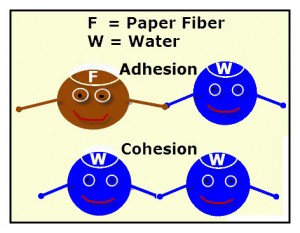Cohesion and Adhesion
When the attractive forces are between unlike molecules, they are said to be adhesive forces. The adhesive forces between water molecules and the walls of a glass tube are stronger than the cohesive forces lead to an upward turning meniscus at the walls of the vessel and contribute to capillary action.
The attractive forces between molecules in a liquid can be viewed as residual electrostatic forces and are sometimes called van der Waals forces or van der Waals bonds.
Cohesion is the property of like molecules (of the same substance) to stick to each other due to mutual attraction. Adhesion is the property of different molecules or surfaces to cling to each other. For example, solids have high cohesive properties so they do not stick to the surfaces they come in contact. On the other hand, gases have weak cohesion. Water has both cohesive and adhesive properties. Water molecules stick to each other to form a sphere. This is the result of cohesive forces. When contained in a tube, the water molecules touching the surface of the container are at a higher level (see Meniscus). This is due to the adhesive force between the water molecules and the molecules of the container.



















0 comments:
Post a Comment